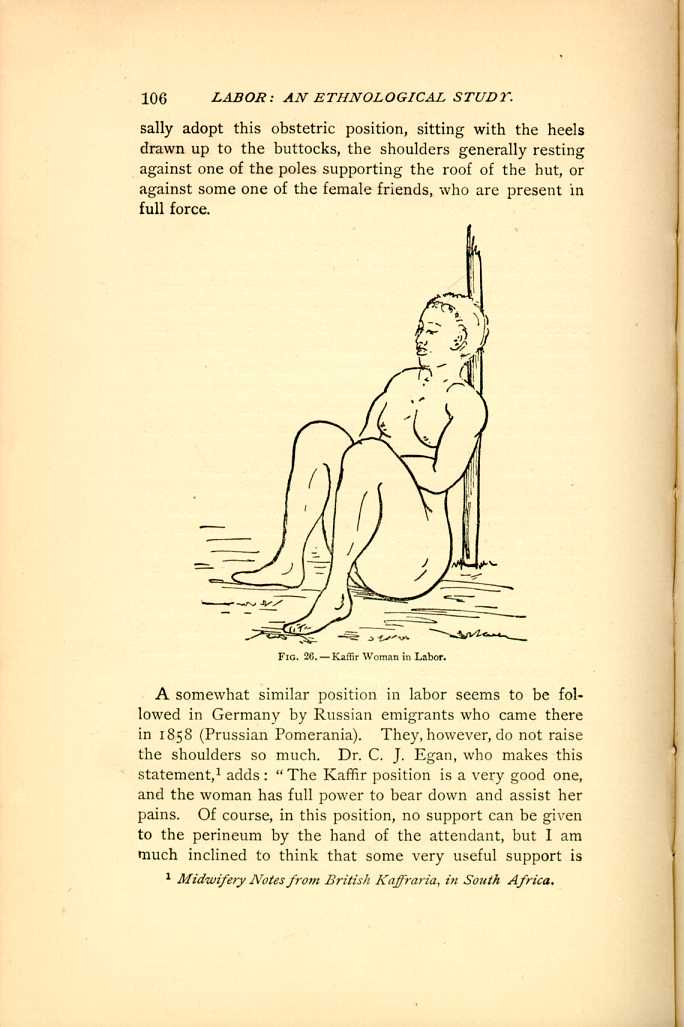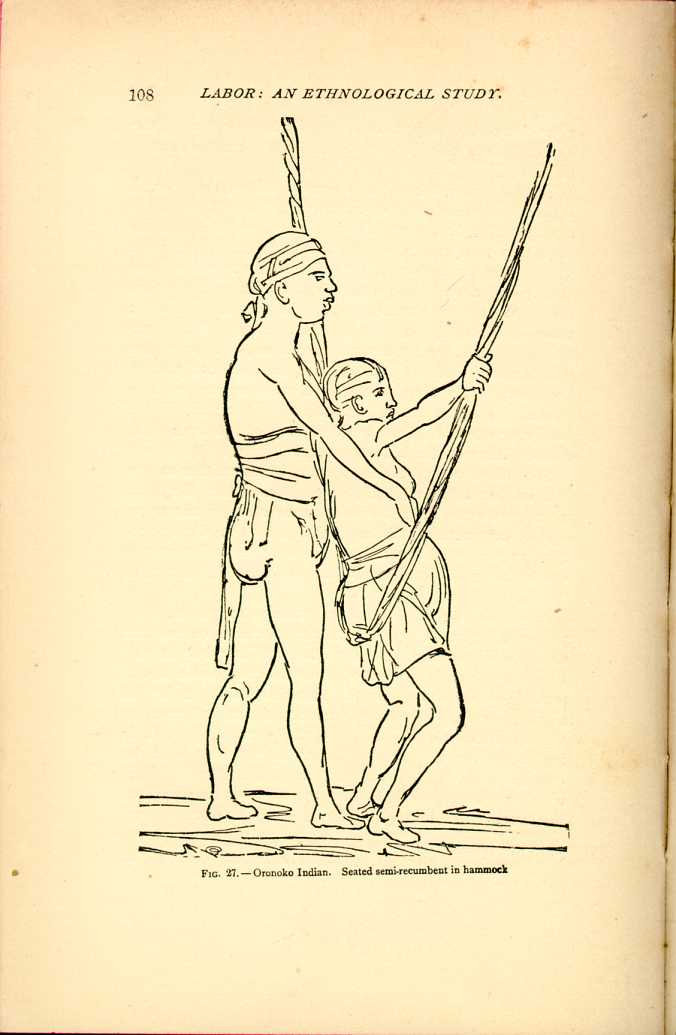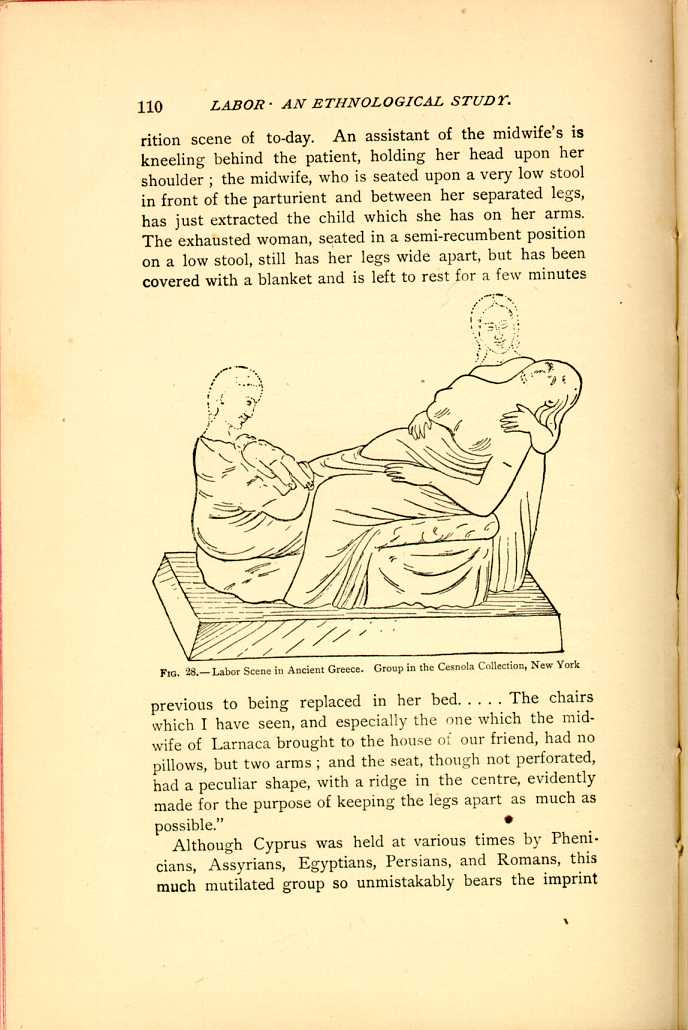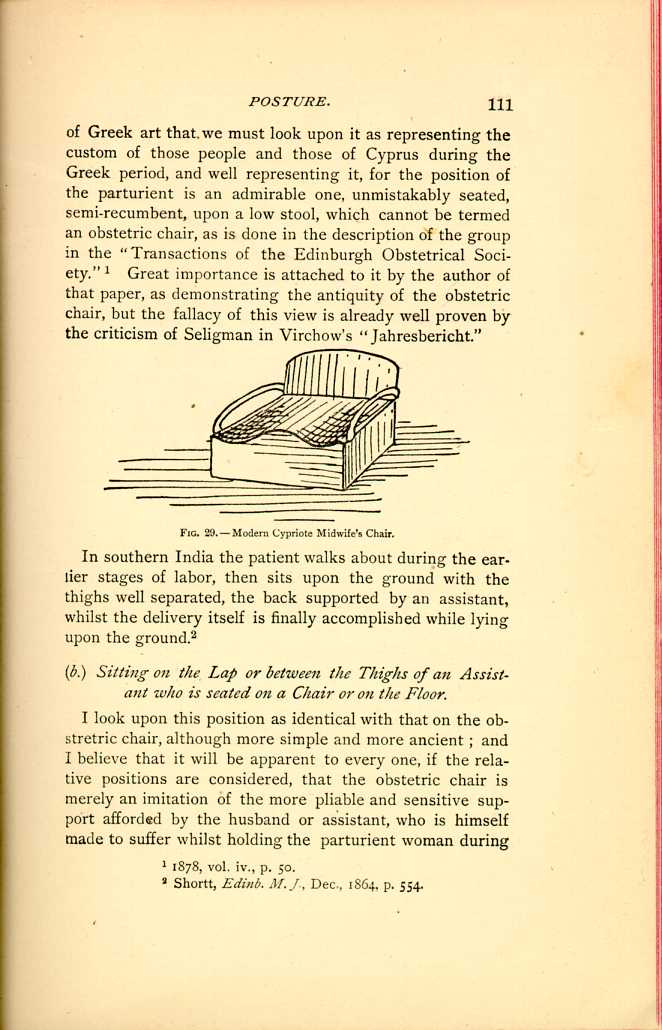| CHAPTER II.
POSTURE IN LABOR. Labor Among Primitive Peoples | ||
(a.) Sitting Semi-recumbent on the Ground, upon a Stone, or Stool.
Among our Indians we find that the Otoes, Missouris, Omahas, Iowas, and nearly related tribes assume the sitting posture, the legs widely separated; but as the crisis supervenes, the patient raises herself somewhat by a rope suspended above, thus attaining an inclined, semi-recumbent position.[90] The Wakah squaw assumes a sitting posture, on the floor of the lodge, with nothing but an Indian mat under her. As soon as the labor pains come on her feet are drawn up close to the buttocks, and the legs flexed; this position is maintained until after the birth of the child and the expulsion of the placenta.[91]
The women of the Skokomish Agency, W. T., sit down with a pillow or roll of blankets resting against the perineum; one squaw supports the back, while another receives the child. This position is a slightly recumbent one, the buttocks resting on the pillow or roll of blankets.[92] The Confederated tribes of the Flatheads, Pend d'Oreilles, and Kootenais, follow a similar custom: a small box, or a piece of wood, six or eight inches high, covered with old pieces of blanket or buffalo robes, is the seat upon which the sick woman is placed; her legs are separated and flexed so that the heels almost come in contact with the seat. She is retained in that position by two assistants who hold her by the arms, and sometimes a third one stands behind and presses upon her shoulders, and in this position the child is expelled.[93]
Though apparently uncomfortable and inconvenient, and rare among the American Indians, the Kaffirs universally

FIG. 26.—Kaffir Woman in Labor.
[Description: Woman sits with her knees up, leaning against a pole. Black and white illustration.]A somewhat similar position in labor seems to be followed in Germany by Russian emigrants who came there in 1858 (Prussian Pomerania). They, however, do not raise the shoulders so much. Dr. C. J. Egan, who makes this statement,[94] adds: "The Kaffir position is a very good one, and the woman has full power to bear down and assist her pains. Of course, in this position, no support can be given to the perineum by the hand of the attendant, but I am much inclined to think that some very useful support is
The Kaffir and the Indian woman sit upon the ground, whilst the somewhat more advanced half-breed, as she is often found in Southern California and New Mexico, seats herself upon a chair, and during the pains, in the same way as her Indian sister, grasps a rope suspended from the ceiling above; but, when tired out in this position, she is often found kneeling upon the ground.[95] A white sister involuntarily testifies to the efficiency of this position, at least under certain conditions,—a primipara who had been in labor for two days and was confined on the third, in a sitting posture, the pains ceasing entirely whenever she assumed a recumbent position; of this the observing attendant, Dr. Von Mansfelde, of Ashland, Neb., assured himself. In order to satisfy himself that it was not the whim of a parturient woman, he placed her on the bed, on her side and back, several times, but the hand placed upon the fundus showed complete relaxation; no sign of contraction. When replaced in the sitting posture the pains readily returned, and were very effective, the woman being delivered within two hours after dilatation of the os.
The Arab woman is seated on two flat stones, or, more properly, her buttocks are slightly supported upon two flat stones, whilst during each pain she partially raises herself by a rope which is suspended from the centre-pole of the tent. Two assistants seize the parturient woman under the shoulders, and she herself, during the pain, raises herself by the rope; they aid this motion, partially suspend her, shaking her well, as the miller does his sack of flour when he empties it, and then, as the pains cease, they drop her back upon the stones. This, at least, was the practice witnessed in several cases in 1858 by Dr. Goguel,[96] in one instance,

FIG. 27.—Oronoko Indian. Seated semi-recumbent in hammock.
[Description: Pregnant woman sits in a hammock resembling a looped rope, while an assistant stands behind her with hands on her abdomen.]A most admirable position, typically semi-recumbent, was customary in Greece and her provinces 2,200 years ago, as is proven by that interesting group, representing a labor just completed, which was discovered by General di Cesnola during his researches in Cyprus; we, moreover, have the same undeniable evidence that this marble group faithfully represents the obstetric position in Cyprus twenty-two centuries ago as we have of the correctness of the Peruvian posture at the time of the Inkas, as pictured upon the funeral urn. The native Peruvians of the present day are still confined whilst seated upon the husband's lap; and the Cypriote midwife of to-day still places her patient in the semi-recumbent position upon a low stool which she carries about with her.
In response to my inquiries, General di Cesnola kindly furnished me with the following most valuable information. He says: "The group was found among the déris of the temple at Golgoi, in 1871, and is of the best Greek epoch, say 400 B. C. The chair on which the woman is reclining, is Cypriote, and was probably used also in Greece at that period; the modern Cypriote midwives possess similar low chairs, which they carry with them when going to attend a child-birth, and I have myself seen the circumstances as shown in that group, which faithfully represents the parturition

FIG. 28,—Labor Scene in Ancient Greece. Group in the Cesnola Collection, New York
[Description: Woman gives birth, assisted by two ghostly figures.]Although Cyprus was held at various times by Phenicians, Assyrians, Egyptians, Persians, and Romans, this much mutilated group so unmistakably bears the imprint

FIG. 29.—Modern Cypriote Midwife's Chair.
[Description: Low midwife's chair, without legs and with arm rails. Black and white illustration.]In southern India the patient walks about during the earlier stages of labor, then sits upon the ground with the thighs well separated, the back supported by an assistant, whilst the delivery itself is finally accomplished while lying upon the ground.[99]
| CHAPTER II.
POSTURE IN LABOR. Labor Among Primitive Peoples | ||